

Headline Inflation
Oriental Mindoro’s headline inflation or overall inflation eased to 1.4 percent in July 2025 from 2.4 percent in June 2025. This brings the provincial average inflation from January to July 2025 to 2.6 percent. In July 2024, the inflation rate was higher at 4.3 percent. (Tables 1, 2 and Figure 1)
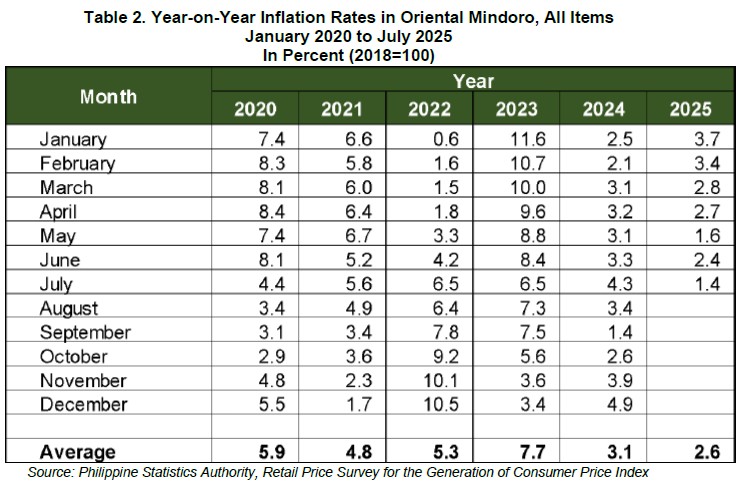
Main Drivers to the Downward Trend of the Headline Inflation
The downtrend in the overall inflation in July 2025 was primarily brought about by the slower annual increase in the housing, water, electricity, gas and other fuels index at 0.8 percent during the month from 4.6 percent in June 2025.
In addition, lower inflation rates were observed in the following commodity groups during the month:
a. Food and alcoholic beverages, 2.2 percent from 2.7 percent;
b. Education services, 8.2 percent from 8.3 percent; and
c. Personal care, and miscellaneous goods and services, 1.0 percent from 1.2 percent.
Moreover, slower annual decrease was observed in the index of transport at 2.9 percent in July 2025 from 3.0 percent annual drop in the previous month. Information and communication recorded an annual increase of 0.2 percent in July 2025 from a 0.1 percent decline in June 2025.
On the contrary, higher inflation rates were noted in the following commodity groups during the month:
a. Furnishings, household equipment and routine household maintenance, 1.4 percent from 1.2 percent;
b. Health, 2.4 percent from 2.3 percent; and
c. Recreation, sport and culture, 2.7 percent from 1.9 percent.
The indices of the rest of the commodity groups retained their respective previous month’s annual growth rates, with financial services still registering a zero percent annual rate in July 2025. (Figure 2)
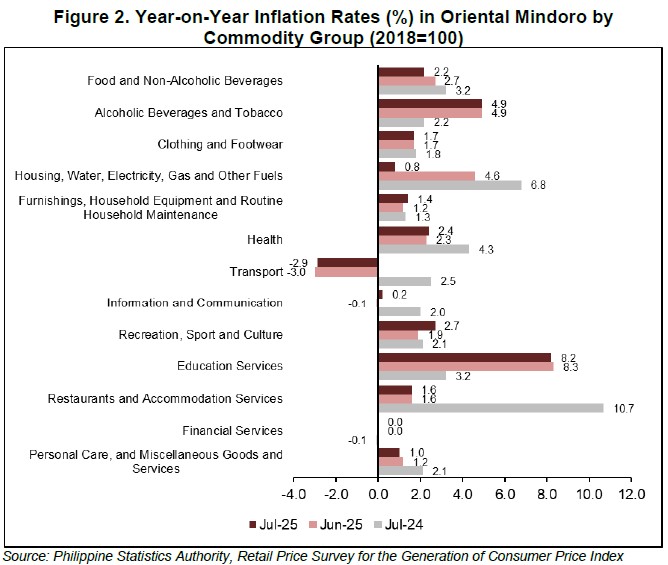
Main Contributors to the July 2025 Headline Inflation
The top three commodity groups contributing to the July 2025 overall inflation of 1.4 percent the province were the following:
a. Food and non-alcoholic beverages with 62.4 percent share or 0.87 percentage points;
b. Alcoholic beverages and tobacco, 13.1 percent share or 0.18 percentage point; and
c. Housing, water, electricity, gas and other fuels with 12.7 percentage share or 0.18 percentage points.
Food Inflation
Food inflation in Oriental Mindoro recorded an annual decline of 2.0 percent in July 2025 from 2.6 percent in the previous month. In July 2024, food inflation was higher at 3.2 percent.
Main Drivers to the Downward Trend of Food Inflation
The year-on-year decrease in the food index in July 2025 was primarily brought about by the faster annual decline of vegetables, tubers, plantains, cooking bananas and pulses at 1.4 percent during the month from 2.2 percent increase in June 2025. Also contributing to the decline in food inflation was the faster annual decrement in rice at 15.0 percent during the month from 13.8 percent decrease in June 2025.
Moreover, lower annual rates were noted in the indices of the following food groups during the month:
a. Corn, 4.1 percent from 8.5 percent;
b. Meat and other parts of slaughtered land animals, 17.6 percent from 18.4 percent;
c. Milk, other dairy products and eggs, 2.1 percent from 3.7 percent;
d. Fruits and nuts, 12.0 percent from 12.3 percent; and
e. Ready-made food and other food products n.e.c., 2.3 percent from 2.9 percent.
INFLATION RATE BY FOOD GROUP
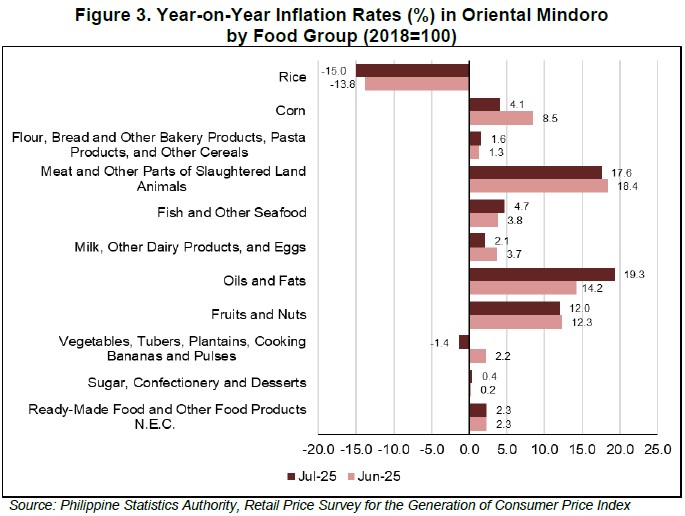
In contrast, higher annual growth rates were observed in the indices of the following food groups during the month:
a. Flour, bread and other bakery products, pasta products and other cereals, 1.6 percent from 1.3 percent;
b. Fish and other seafood, 4.7 percent from 3.8 percent;
c. Oils and fats, 19.3 percent from 14.2 percent; and
d. Sugar, confectionery and desserts, 0.4 percent from 0.2 percent. (Figure 3)
Purchasing Power of the Peso
The Purchasing Power of Peso (PPP) in Oriental Mindoro remained Php 0.72 in July 2025.
As a result, the amount of goods that could be presently purchased by consumers was less than when the PPP was higher. Furthermore, the decrease in PPP was attributed to the higher inflation rate, given that PPP and inflation rate have an inverse relationship.
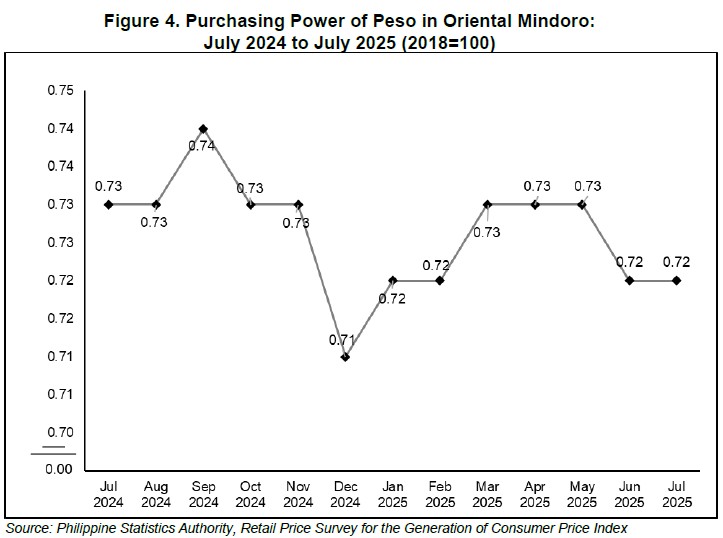
(SGD) CHARLYN ROMERO-CANTOS, PhD
(Chief Administrative Officer)
Officer-in-Charge
Oriental Mindoro Provincial Statistical Office
HTD/JGO
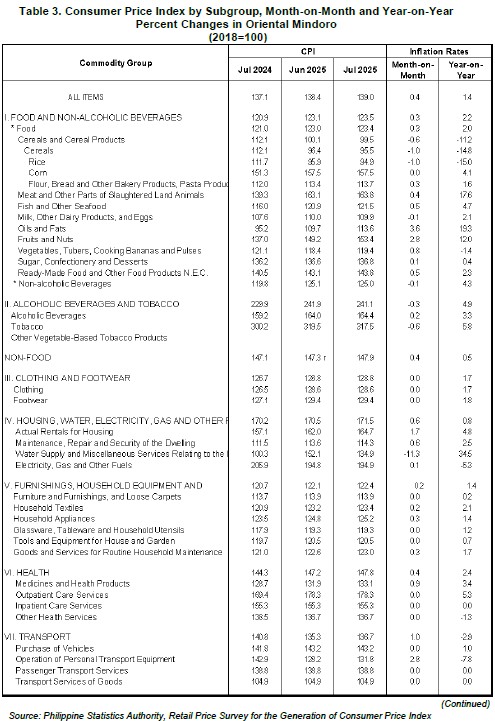
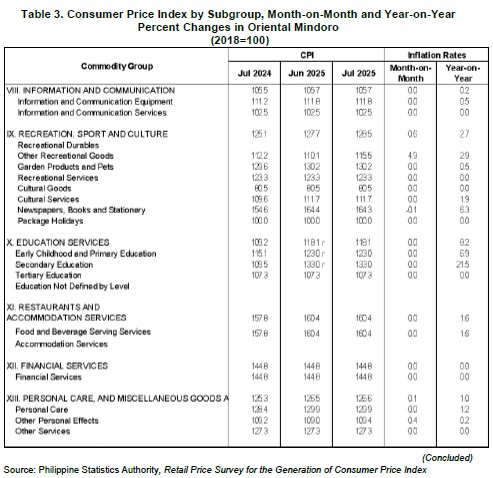
TECHNICAL NOTES
Consumer Price Index is an indicator of the change in the average prices of a fixed basket of goods and services commonly purchased by households relative to a base year.
Market Basket is a sample of goods and services, which is meant to represent the totality of all the goods and services purchased by households relative to a base year.
To determine the commodities that will form the market basket for the 2018-based CPI, the Survey of Key Informants (SKI) was conducted in March 2021. The survey, which was conducted nationwide to store managers, sellers or proprietors, obtained information on the most commonly purchased of goods and availed of services by the households.
Base year is a reference period, usually a year, at which the index number is set to 100. It is the reference point of the index number series. The CPI is rebased from base year 2012 to base year 2018.
Inflation Rate is the annual rate of change or the year-on-year change in the Consumer Price Index (CPI).
- Purchasing Power of Peso is a measure of the real value of the peso in a given period relative to chosen reference period. It is computed by getting the reciprocal of the CPI and multiplying the result by 100


